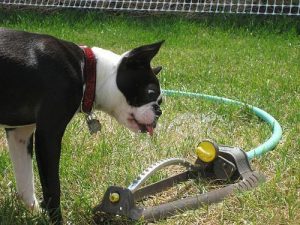By Sherry L. Granader.
Have you ever had heat stroke? Have you experienced the rapid heartbeat, shallow breathing, overwhelming body heat, nausea and light-headedness? Now imagine feeling those same frightening symptoms, while wearing a heavy fur coat with no way to cool down!
That’s what your dog feels when they suffer from heat stroke.
Hyperthermia – or heat stroke – is a serious health issue that can cause permanent bodily damage, multiple organ dysfunction and even death if not immediately – and properly – treated. Keep reading to learn more about heat stroke in dogs, the signs you need to look for and the easy ways you can avoid heat stroke in your dog. 
Heat Stroke in Dogs
Unlike humans, dogs do not sweat to cool down (except for minimal sweating through their foot pads). Dogs primarily cool themselves through panting. But when the air temperature is the same as their body temperature, panting is no longer cooling their body. Body temperatures of 103° F (or 39° C) or higher can lead to dangerous results if left unchecked.
Bulldogs, Pugs and Pekingese (known as brachycephalic breeds) are particularly susceptible to heat stroke because of their short noses, which inhibit effective breathing and cooling. Thick- or long-haired dogs, overweight or obese and young canines are all at the highest risks for heat stroke.
Heat stroke also creates a rapid loss of fluids. When your dog loses fluids faster than he’s replacing them – as in the vomiting and diarrhea associated with heat stroke – dehydration becomes a potentially deadly issue requiring immediate veterinarian attention.
Prevention is the best way to avoid heat stroke. Dogs do not self-monitor themselves very well, so carefully watch your dog in hot temperatures and keep her inside to make sure she stays cool.
Signs of Heat Stroke
According to pets.webmd.com, signs of heat stroke include the following:
- Heavy panting; labored breathing
- Rapid and irregular heart beats
- Bright red tongue and gums
- Excessive drooling; thick saliva
- Vomiting
- Rectal temperatures of 104° to 110° F (or 40° to 43.3° C)
- Bloody diarrhea
- Unsteadiness; wobbliness
- Collapse, Seizures, Shock, Coma and possibly death
After Effects of Heat Stroke
Always have your dog evaluated by your vet after a heat stroke attack. While the immediate danger may have seemed to pass, there are potential long-term and permanent after effects of heat stroke; including:
- Kidney failure
- Laryngeal trauma/edema (WikiPet: sudden swelling of the larynx)
- Spontaneous bleeding
- Irregular heartbeat
- Seizures
Again, while the immediate dangers of heat stroke appear to have passed, these complications listed above can occur hours – or even days – after a heat stroke episode.
5 Ways to Avoid Heat Stroke
- Never leave your dog in a car.
- Prevent your dog from doing strenuous exercise in hot, humid weather. Exercise only in the cool early morning or late evening hours. Carefully watch your dog for signs of labored breathing.
- Bring water during your dog walks and avoid walking on hot concrete or asphalt surfaces.
- Bring your pet indoors. However, if you must leave them outside, provide adequate shade and plenty of fresh water in hot temperatures.
- Never muzzle your dog while using a hair dryer to dry their wet fur. Grooming is not something many associate with heat stroke. Some groomers use a cage dryer so special consideration should be given to those who are overweight, have breathing problems, as well as those who may be overly stressed and older dogs.
Heat stroke in your dog is a serious medical and life-threatening condition. But even with your best efforts, your dog may still get heat stroke at one time or another. Read our article “What to do when your Dog DOES get Overheated,” to learn how to quickly and properly treat your dog’s heat stroke.
Reviewed and approved by Dr. David L. Roberts, DVM
Photo: Courtesy of anneheathen via flickr (CC By 2.0)









